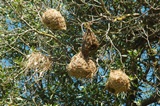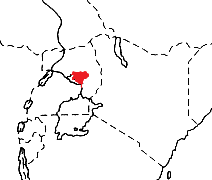Weaver species
Choose different species from drop-down list and press 'Go' button. See Full species list.Fox's Weaver Ploceus spekeoides
IUCN: Near threatened Discovery: 113Categories: wetland, IUCN,
News items about species
Discovery
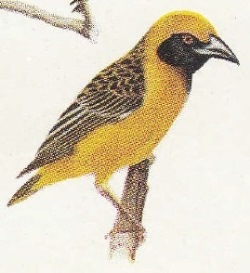
figure from Mackworth 1955a 
figure from Mackworth 1955a 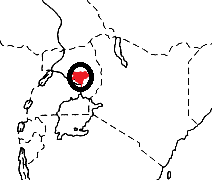
distribution, type locality circled IntroductionThe Fox's Weaver was formally described by Captain Claude Henry Baxter Grant, a British ornithologist and collector, and by Cyril Winthrop Mackworth-Praed, a British sport shooter & ornithologist.The Fox's Weaver was collected by Harold Munro Fox, an English zoologist. Grant and Mackworth-Praed originally listed the collector as TV Fox, but this is presumably an error, and Beolens 2003a listed the collector as Harold Munro Fox. Fox went to Naples, Italy, in 1912, where he worked on fertilisation at the Stazione Zoologica for ten months. In 1913 he was appointed lecturer in zoology at the Royal College of Science, London, by Ernest William MacBride. Presumably in this time he visited Uganda, where he collected 2 specimens of Fox's Weaver, a male on 30 July 1913 at Ngariam, and a female on 14 August 1913 at Usuku. Fox gave these specimens Stephenson Robert Clarke, who presented his own (and these) African specimens to the British Museum in 1923. The Fox's Weaver specimens were overlooked until 1947 when Grant and Mackworth-Praed recognised this as a new species. The Fox's Weaver was first illustrated by Mackworth 1955a as a colour painting of a male and a female. Scientific citationPloceus spekeoides Grant and Mackworth-Praed (Grant 1947a), Bull. Br. Orn. Club 68 p.7, Ngariam, Teso, Uganda.Meaning of namesspekeoides, Greek: -oides, resembling; ie resembles Ploceus spekei (spekei - Named after Captain John Hanning Speke).First English nameFox's Weaver (Mackworth 1955a).Alternate namesNone.CollectorHarold Munro Fox.Date collected30 Jul 1913 and 14 Aug 1913.Locality collectedNgariam, and Usuku, both in Teso, central Uganda.Type specimensThe types are in the British Museum (holotype BM_1923.8.7.2128). |
The above is based on Weaver Wednesday 2, a weekly series about the discovery of each weaver species.
This species text first appeared as
Weaver Wednesday [230] - Discovery [113]: Fox's Weaver on 2016-11-09
1. Basic biology
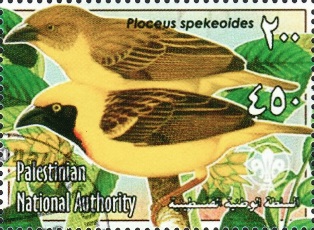
figure from Palestinian stamp The female Fox's Weaver is dull, with yellow rump and underparts, and with heavy dark steaks on the crown and back. Distribution.
Fox's Weaver is found in central Uganda (see map below, based on Birds of Africa). It has been recorded at, and around, Lakes Bisina and Opeta; at Rhino Camp (in Arua) and around Lake Kyoga (near Nakasongola). Fox's Weaver was first collected at Nariam Swamp, but this wetland has since been drained. Every year during the Oct-Feb dry season, large numbers of cattle move to the Opeta region for grazing, which degrades the wooded grassland on which this weaver depends for breeding. Fox's Weaver is considered Near-threatened as it has a restricted range and is very poorly known.
Habitat. Fox's Weaver inhabits bushed and wooded grassland in swampy areas, but in the dry season it seems to leave the breeding sites. Food. The Fox's Weaver feeds on seeds, and probably on insects. Breeding. The Fox's Weaver is apparently colonial. The nest is oval, roughly woven and without an entrance tunnel. It nests in swamps. In 1996, 47 nests were counted around Lake Bisina. There is no other information on eggs or breeding. |
The above is based on Weaver Wednesday, a weekly series about weaver species.
This species text first appeared as
Weaver Wednesday [105]: Fox's Weaver on 2014-06-18
2. Breeding facts
| Pair bond unknown Breeding season May-Aug Nest site no information Nest building no information Colony size apparently colonial Clutch size no information Egg colour no information Egg size no information Incubation no information Chicks and nestling period no information |
Breeding information based on Handbook of the Birds of the World, Vol. 15.
3. Photos of Weaver Nests
No records yet - be the first to submit a PHOWN record!See PHOWN summary page for this species here.
PHOWN (Photos of Weaver Nests) provides valuable info on breeding distribution and colony sizes of weavers.
You can contribute by registering and submitting photos at Virtual Museum webpage.
4. Breeding distribution
Google map showing distribution (For species with small ranges you need to zoom in at the correct area to see the range):
yellow blob - range of weaver species; read more about this here.
![]() - PHOWN records with photos
- PHOWN records with photos
![]() - PHOWN records with no photos (Nest Record Cards, other records)
- PHOWN records with no photos (Nest Record Cards, other records)
![]() - Birdpix records
- Birdpix records
![]() - comments on out of range records, or interesting records
- comments on out of range records, or interesting records
![]() - type locality
- type locality
CLICK on the marker on the map to see individual record details.
5. Range changes
Not South African speciesThe above is based on Weaver Wednesday 3, a weekly series about range changes in South African weaver species.
This species text first appeared as
n/a








